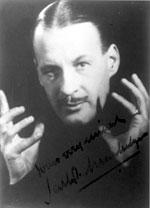Jasper Maskelyne
| Jasper Maskelyne | |
|---|---|
 |
|
| Born | 1902 London, England |
| Died | 1973 (aged 70–71) Kenya |
| Nationality | British |
| Occupation | Stage magician |
| Known for | Stories of wartime exploits |
| Parent(s) |
Nevil Maskelyne Ada Mary Ardley |
Jasper Maskelyne (1902–1973) was a British stage magician in the 1930s and 1940s. He was one of an established family of stage magicians, the son of Nevil Maskelyne and a grandson of John Nevil Maskelyne. He is most remembered, however, for his entertaining accounts of his work for British military intelligence during the Second World War, in which he claims that he created large-scale ruses, deception, and camouflage.
Maskelyne was a successful stage magician. His 1936 Book of Magic describes a range of stage tricks, including sleight of hand, card and rope tricks, and illusions of "mind-reading".
A 1937 Pathé film, The Famous Illusionist, was made of Maskelyne, looking dapper and apparently eating a boxful of razor blades, one at a time.
Maskelyne joined the Royal Engineers when the Second World War broke out, thinking that his skills could be used in camouflage. A story runs that he convinced sceptical officers by creating the illusion of a German warship on the Thames using mirrors and a model.
Maskelyne was trained at the Camouflage Development and Training Centre at Farnham Castle in 1940. He found the training boring, asserting in his book that "a lifetime of hiding things on the stage" had taught him more about camouflage "than rabbits and tigers will ever know". The camoufleur Julian Trevelyan commented that he "entertained us with his tricks in the evenings" at Farnham, but that Maskelyne was "rather unsuccessful" at actually camouflaging "concrete pill-boxes".
Brigadier Dudley Clarke, the head of the 'A' Force deception department, recruited Maskelyne to work for MI9 in Cairo. He created small devices intended to assist soldiers to escape if captured and lectured on escape techniques. These included tools hidden in cricket bats, saw blades inside combs, and small maps on objects such as playing cards.
...
Wikipedia
